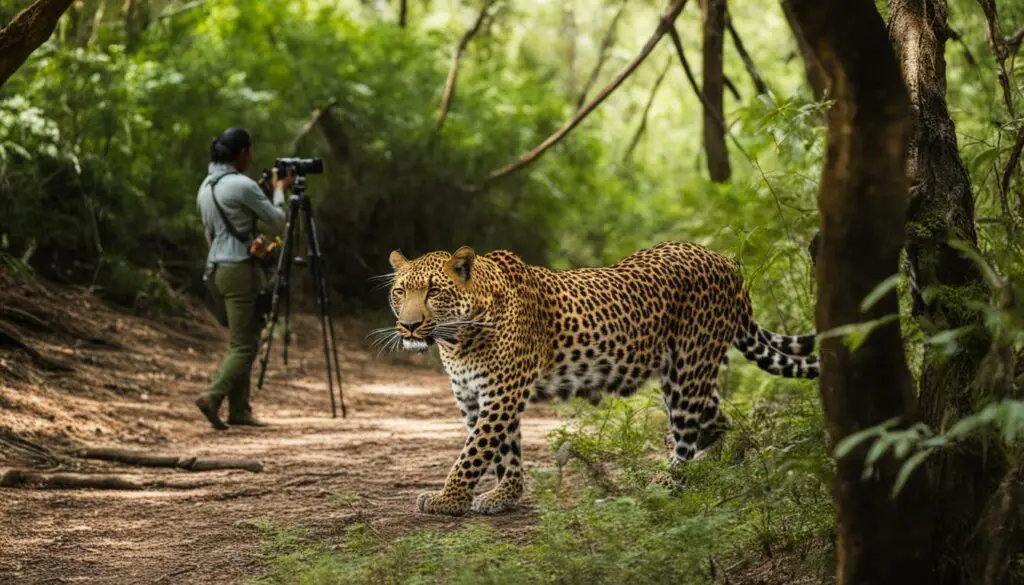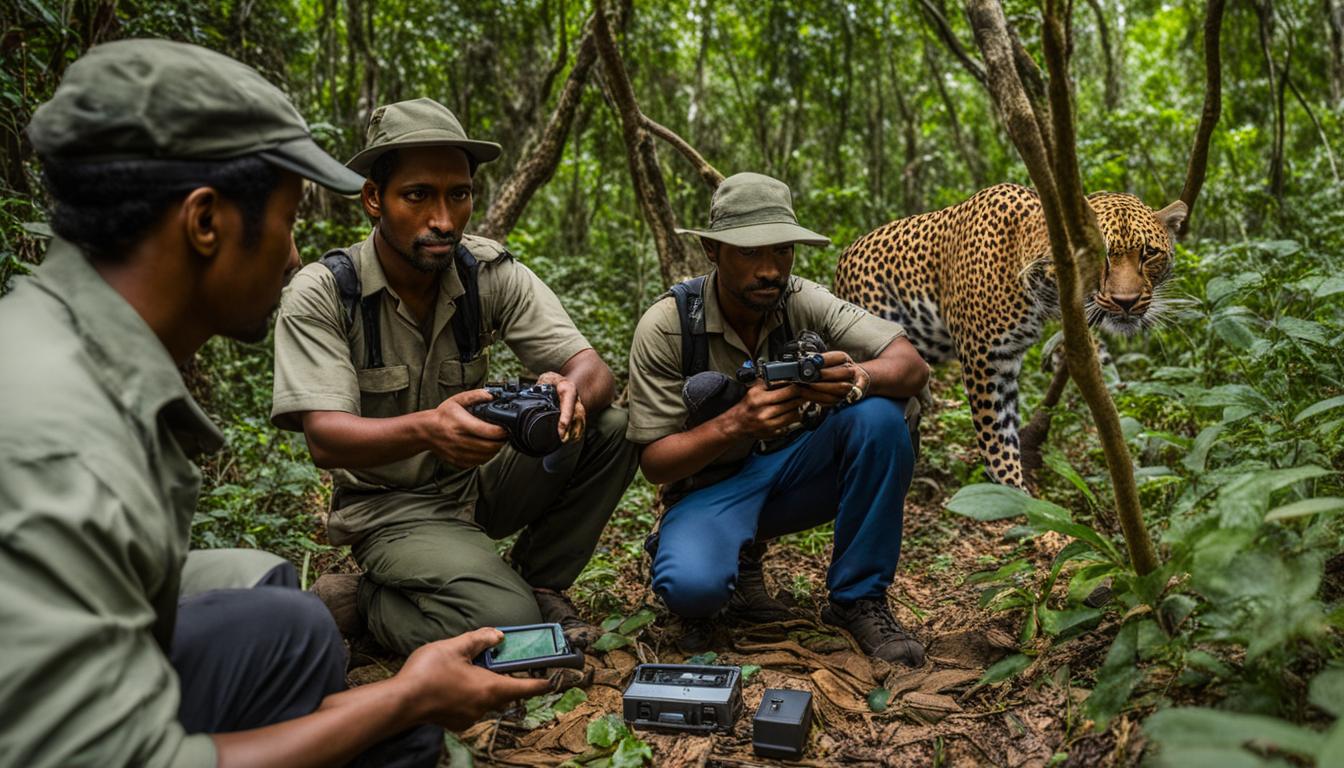Welcome to the fascinating world of leopard tracking and study! In this article, we will delve into the innovative techniques and cutting-edge research tools used by researchers to understand these majestic wild cats and contribute to their conservation. Join us as we explore the exciting world of leopard tracking and study, where wildlife research meets the conservation of these magnificent creatures.
Leopards are enigmatic creatures that roam the wild landscapes, and studying their behavior, habitat use, and population dynamics is crucial for their long-term survival. Through a combination of research cameras, GPS tracking, ecological surveys, and genetic research, scientists are able to gather valuable insights into leopard populations. By tracking and studying leopards, researchers can inform conservation efforts and contribute to a better understanding of these incredible animals.
Using Research Cameras to Monitor Leopard Behavior
Research cameras are an essential tool used by wildlife researchers to gain insights into the behavior of wild leopards. These cameras, also known as trail cameras or camera traps, are strategically placed in predetermined areas within the leopard’s home range. Equipped with heat sensors, they are able to detect the presence of leopards and capture a series of photographs as the animals move through the area.
These photographs are invaluable in helping researchers identify individual leopards based on their unique spot patterns. By studying these images, researchers can analyze leopard behavior, movement patterns, and interactions with their environment. The data collected from research cameras provides valuable information that contributes to a better understanding of leopard populations, their habitat use, and the factors that influence their behavior.
Additionally, research cameras allow researchers to estimate population sizes and assess the distribution of leopards within a given area. This data can be used to inform conservation efforts and develop effective strategies to protect leopard populations and their habitats. By utilizing tracking technology such as research cameras, scientists can gain crucial insights into the behavior and conservation needs of these majestic wild cats.
| Benefits of Using Research Cameras | Insights Gained |
|---|---|
| Identification of individual leopards based on spot patterns | Understanding leopard behavior and movement patterns |
| Estimation of population sizes and distribution | Assessing leopard habitat use and conservation needs |
| Identification of key areas for protection | Informing conservation efforts and strategies |
Using Research Cameras to Understand Leopard Behavior
Research cameras provide researchers with unique opportunities to study leopard behavior in their natural environment. By capturing images of leopards as they go about their daily routines, scientists can observe feeding habits, hunting techniques, and social interactions. This information helps researchers gain a deeper understanding of the ecological role that leopards play in their ecosystems and aids in the development of effective conservation strategies.
GPS Tracking to Understand Leopard Movement
GPS tracking technology plays a crucial role in studying the movement patterns and habitat use of wild leopards. By fitting GPS tracking collars onto individual leopards, researchers can gather valuable data on their daily activities, ranging behavior, and interactions with their environment. This information provides insights into the home range size, preferred hunting grounds, and potential threats faced by these majestic creatures.
GPS tracking collars equipped with GPS devices and batteries are carefully placed on leopards, ensuring minimal disturbance to their natural behavior. The collars collect location data at regular intervals, allowing researchers to map out the precise movements of each individual. This data is then analyzed to identify core areas within the leopard’s home range, crucial for their survival and successful reproduction.
| Data Collected | Insights Gained |
|---|---|
| Movement patterns | Understanding how leopards navigate their habitat and utilize different areas. |
| Habitat use | Identifying preferred hunting grounds and potential conflicts with human activities. |
| Interactions with prey | Assessing the availability of prey species and the impact of leopard predation on local ecosystems. |
| Interactions with other leopards | Exploring social dynamics, territorial boundaries, and potential breeding opportunities. |
By combining GPS tracking data with other research methods, such as camera trapping and genetic analysis, scientists can gain a comprehensive understanding of leopard behavior and the factors influencing their survival. This knowledge is crucial for developing effective conservation strategies to protect leopard populations and their habitats for future generations.
Ecological Surveys to Assess Leopard Habitat
Ecological surveys are crucial for monitoring and studying leopard populations in their natural habitats. These surveys provide valuable insights into leopard habitat preferences, distribution, and population sizes. By gathering data on leopard signs such as scrapes, scat, and scent markings, researchers can gain a better understanding of leopard behavior and their interactions with the environment.
Additionally, ecological surveys involve conducting interviews with local communities to gather information on their knowledge of leopard ecology and attitudes towards conservation. This community-based approach helps researchers identify potential human-wildlife conflicts and develop strategies to mitigate them. It also fosters a sense of ownership and collaboration among community members, contributing to long-term conservation efforts.
One of the key benefits of conducting ecological surveys is the identification of important leopard habitats. By documenting leopard signs and understanding their distribution patterns, researchers can pinpoint critical areas for protection and implement conservation measures accordingly. These surveys also aid in assessing the health of leopard populations and identifying any potential threats they may face.
The Importance of Wildlife Monitoring
Wildlife monitoring, including ecological surveys, plays a vital role in wildlife conservation. It helps researchers and conservation organizations gather essential data to inform management decisions and ensure the long-term survival of endangered species like leopards. By monitoring leopard populations and their habitats, we can understand their ecological needs, evaluate conservation efforts, and address any challenges they may face.
Table: Summary of Ecological Survey Findings
| Key Findings | Implications |
|---|---|
| High presence of leopard signs in a particular area | Identification of important leopard habitat for protection |
| Community knowledge of leopard behavior and ecology | Development of community-based conservation initiatives |
| Identification of potential human-wildlife conflicts | Implementation of strategies to mitigate conflicts |
| Assessment of leopard population health | Monitoring of population trends and conservation efforts |
Ecological surveys provide valuable information for understanding and conserving leopard populations. By combining scientific research with community engagement, we can work towards ensuring the long-term survival of these majestic creatures and the ecosystems they inhabit.

Future Directions in Leopard Research
As technology continues to advance, new and innovative wildlife tracking methods are being developed to enhance leopard research initiatives and promote endangered species conservation. Scientists and researchers are constantly exploring ways to improve our understanding of leopard behavior, population dynamics, and habitat use. These efforts are crucial for effective conservation strategies and the long-term survival of these magnificent creatures.
One of the exciting developments in leopard research is the use of advanced tracking technologies. For example, researchers are experimenting with using satellite tags to monitor leopard movements in real-time. These tags provide valuable data on leopard migration patterns, home ranges, and potential threats. By tracking leopards in this way, scientists can gain a deeper understanding of their behavior and identify key areas for conservation efforts.
Collaborative research initiatives are also playing a vital role in leopard research. Scientists from different institutions and organizations are coming together to share data, knowledge, and resources. By pooling their expertise, they can tackle complex research questions and develop comprehensive conservation strategies. These collaborative efforts are essential for the effective protection and management of leopard populations.
Table: Current and Emerging Wildlife Tracking Methods
| Tracking Method | Description |
|---|---|
| Satellite Tags | Real-time tracking of leopard movements using satellite technology. |
| Camera Traps | Continued use of research cameras to monitor leopard behavior and habitat use. |
| Acoustic Monitoring | Recording and analyzing leopard vocalizations to understand communication and behavior. |
| Remote Sensing | Using satellite imagery to assess leopard habitat and population dynamics. |
In addition to technological advancements, it is also important to consider the social and economic aspects of leopard conservation. Engaging with local communities, promoting sustainable practices, and raising awareness about the importance of leopard protection are key components of successful conservation efforts. By involving the local population in conservation initiatives, we can foster a sense of stewardship and create a sustainable future for both leopards and humans.
In conclusion, the future of leopard research is bright. Through the development of innovative tracking methods, collaborative research initiatives, and a holistic approach to conservation, we can ensure the long-term survival of these majestic wild cats. By continuing to invest in leopard research, we not only protect a species but also safeguard the delicate ecosystems they inhabit. Together, we can make a difference and secure a future where leopards thrive in the wild.
Conclusion
Leopard tracking and study efforts are essential for gaining insights into the behavior, habitat needs, and population dynamics of wild leopard populations. By using cutting-edge research tools such as research cameras, GPS tracking collars, ecological surveys, and genetic research, researchers can gather valuable data to inform leopard conservation strategies.
The information collected through these wildlife research methods allows us to better understand leopard behavior, movement patterns, and interactions with their environment. It also helps assess population size, genetic diversity, and potential threats to their survival. Armed with this knowledge, researchers and conservation organizations can develop targeted conservation programs that focus on protecting important leopard habitats and mitigating human-wildlife conflicts.
By studying leopards in their natural habitats, we can ensure the long-term survival of these magnificent creatures and the delicate ecosystems they inhabit. It is through leopard tracking and study that we can make a real difference in leopard conservation and contribute to the preservation of our planet’s biodiversity.
What technologies and methods are commonly used to study and track wild big cat populations?
When researching wild cheetah populations tracking, scientists commonly use methods such as camera traps, satellite collars, and genetic analysis. These technologies help researchers gather data on the movement, behavior, and population size of wild big cats, ultimately aiding in conservation efforts and future management strategies.
FAQ
How do researchers track and study wild leopard populations?
Researchers track and study wild leopard populations using cutting-edge research tools such as research cameras, GPS collars, and genetic analysis. These tools provide valuable information about leopard behavior, habitat use, population size, and genetic diversity.
What are research cameras used for in monitoring leopard behavior?
Research cameras are set up in predetermined areas to capture photographs of wild leopards as they move throughout their home ranges. The cameras use heat sensors to detect the presence of leopards and take a series of photographs. This information helps researchers identify individual leopards based on spot patterns and understand their behavior, movement patterns, and interactions with their environment.
How are GPS tracking collars used in studying leopard movement?
GPS tracking collars are fitted onto leopards and provide data on their habitat use, movement patterns, and interactions with prey and other leopards. This information helps researchers gain a better understanding of leopard home ranges, hunting behavior, and potential threats to their survival. It also allows for the identification of important leopard habitats and the design of effective conservation strategies.
What are ecological surveys used for in assessing leopard habitat?
Ecological surveys involve documenting snow leopard signs like scrapes, scat, and scent markings, as well as conducting interviews with local communities to understand their knowledge of leopard ecology and attitudes towards conservation. By understanding the ecological dynamics of leopard habitat, researchers can identify key areas for protection, assess the health of leopard populations, and address human-wildlife conflicts.
How does genetic research contribute to the study of leopard populations?
Genetic research is used to study leopard populations at a genetic level, providing insights into population health, genetic diversity, and breeding patterns. Scientists collect scats and hairs and extract DNA to determine the identity of individual leopards and their relationships to one another. This information helps assess the overall health and genetic diversity of leopard populations.
How do the tracking and study efforts of leopards contribute to conservation?
The data collected from leopard tracking and study efforts are used to inform and guide conservation efforts. By understanding leopard behavior, habitat use, and population dynamics, researchers and conservation organizations can develop targeted conservation programs that focus on the most critical areas and threats. This may involve implementing community-based conservation programs, improving prey species management, mitigating human-wildlife conflicts, and implementing measures to protect important leopard habitats.
What are the future directions in leopard research?
The field of leopard research is continuously evolving, with scientists developing new tracking methods and technologies to enhance the study of leopard behavior, population dynamics, and habitat use. This includes the use of innovative tracking technologies, advanced data analysis techniques, and collaborative research initiatives. The goal is to improve our understanding of leopards and their conservation needs, ultimately ensuring the long-term survival of these magnificent creatures.
Why is leopard tracking and study important for wildlife conservation?
Leopard tracking and study efforts play a crucial role in understanding the behavior, habitat needs, and population dynamics of wild leopard populations. The data collected from research cameras, GPS tracking, ecological surveys, and genetic research are instrumental in informing conservation efforts and ensuring the long-term survival of these magnificent creatures. By studying leopards in their natural habitats, researchers can develop effective strategies to protect these iconic animals and their fragile ecosystems.











